The bench press may not be your best bet for big pecs. Make no mistake, barbells are fantastic tools for getting stronger and gaining muscle. They don’t need to be the start and end of your exercise routine, though.
To sculpt and shape your pecs, you should incorporate movements like the cable crossover into your workout routine. This exercise has a few things going for it that merit inclusion into any chest-focused workout, whether you’re a bodybuilding enthusiast or not.
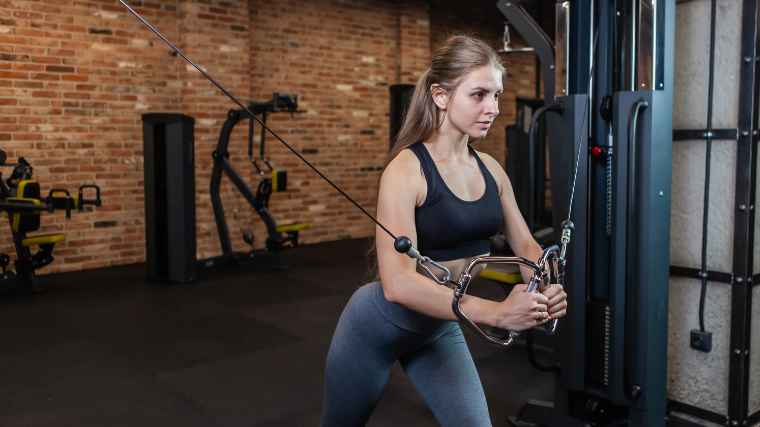
Here’s everything you need to know, and a little more, about the crossover and how to perform it perfectly.
- How to Do the Cable Crossover
- Cable Crossover Sets and Reps
- Common Cable Crossover Mistakes
- Cable Crossover Variations
- Cable Crossover Alternatives
- Muscles Worked by the Cable Crossover
- Benefits of the Cable Crossover
- Who Should Do the Cable Crossover
- Frequently Asked Questions
How to Do the Cable Crossover
To get started with the cable crossover, all you’ll need is, well, a cable station with two adjustable “arms” or an adjustable vertical pin.
Most gyms will also have an assortment of different handles, so you can find one that fits comfortably in your palm.
Step 1 — Find the Right Height
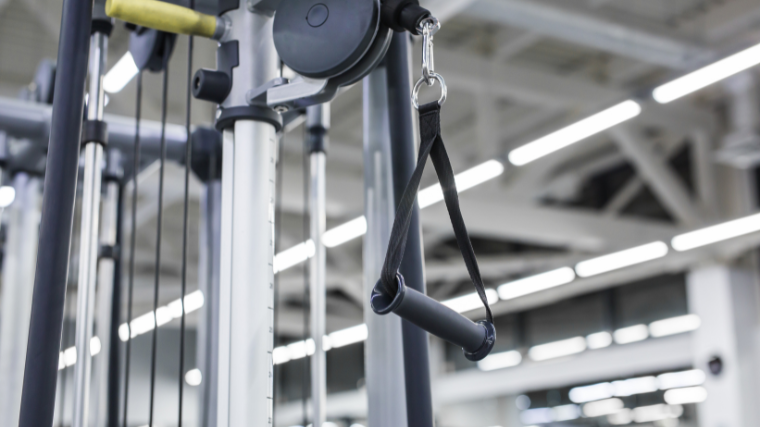
The standard cable crossover is performed from a standing position. Therefore, you should adjust the height of the cable pulleys such that they’re roughly around shoulder level or slightly above.
Coach’s Tip: Take a moment to find the exact right height that is comfortable for you.
Step 2 — Grab and Brace
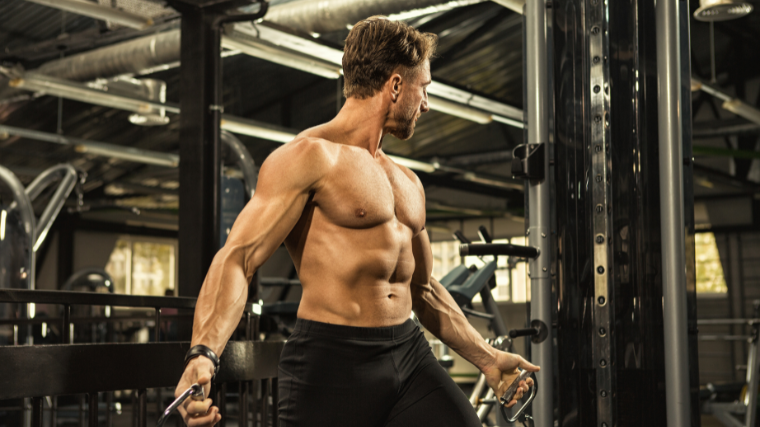
Once you’ve got the handles at the proper height, grab one in each hand, take a small step out, and tilt your torso forward slightly as if you were going to bow. Your arm should align with the cable itself.
Coach’s Tip: Your arm should be just a bit behind your torso in the starting position.
Step 3 — Draw and Squeeze
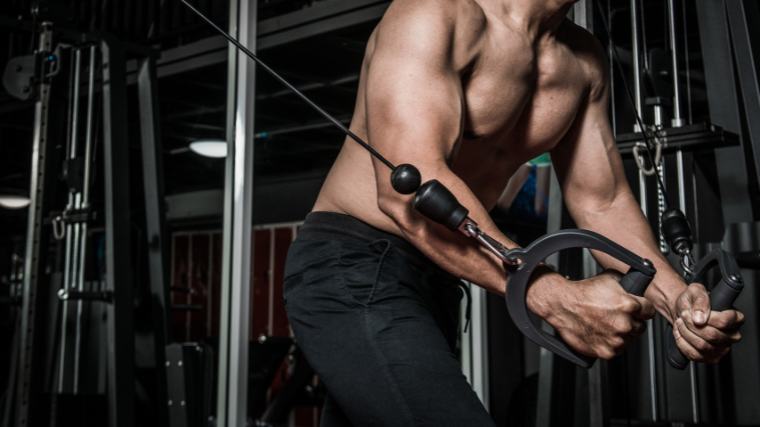
From the starting position, draw your arms across your body toward your midline with your elbows loose and mostly straight. Your hands should criss-cross each other at roughly sternum-height at the end of the repetition.
Coach’s Tip: Alternate which hand passes the other on each rep of the crossover.
Cable Crossover Sets and Reps
The crossover is not the most versatile exercise out there. It’s an isolation movement specifically meant to train your pecs — that doesn’t mean that you can’t attack different fitness-related goals with it, though.
Your best bet is to program the crossover to fulfill one of these two primary purposes:
- For Muscle Growth: 3 to 4 sets of 8 to 12 reps with a moderately-heavy weight.
- For Endurance: 2 to 3 sets of as many as 20 reps with a light weight and limited rest.
Common Cable Crossover Mistakes
It may not be as technical as, say, a snatch or sumo deadlift, but there are certainly a few specific elements to be aware of before you get started with the cable crossover.
Not Crossing Your Hands
If you’re performing a crossover movement, you probably want to actually cross your hands at the end of each rep. Doing so allows you to utilize the full range of motion of your chest, which may help you grow your pecs a bit quicker.
Using Momentum
Adding some “body English” or intentional cheating can help you lift more weight, but it might cost you proper form and your muscular engagement along with it.
When you do cable crossovers, make sure to brace your trunk and stagger your footing so you have enough stability to remain motionless. The only parts of your body that should really move are your arms.
Bending Your Elbows
The hallmark feature of any “flye” motion is adduction of the arm — bringing it from an outward position in toward your torso using just your pecs.
As such, you should avoid performing the cable crossover with a flexed elbow, as this can make the exercise too easy and increase biceps activation at the cost of engaging your chest.
Cable Crossover Variations
The design of the cable crossover makes it more than customizable to your needs. If you aren’t keen on the as-written exercise, feel free to take one of these variations for a spin.
Single-Arm Cable Crossover
One of the biggest perks of working without the barbell is the ability to train each side of your body independently.
If you have an imbalance in your chest development or want to take the time to really hone in on the muscular contraction on each side, you can simply perform crossovers with one arm at a time. Make sure you use your free arm to help stabilize your body during the set.
Low-to-High Cable Crossover
Altering the angle of your crossover might help you engage a different part of your pecs. Adducting your arm from a low-handled position is typically considered a valid way of emphasizing your pectoralis minor, or upper chest.
[Read More: Best Upper Chest Exercises for Building Muscle]
You’re also liable to get some extra front deltoid work as well, which may add to (or subtract from) the value of this variation.
Cable Crossover Alternatives
Cables might be uncomfortable for you. Or, someone with poor gym etiquette might be hogging the station for way, way too long.
In either case, you can still develop your chest without having to hit up the bench press by trying out one of these alternatives.
Dumbbell Flye
The go-to alternative to cable work is to grab a pair of dumbbells. The dumbbell flye will work the same range of motion and engage the same muscles the cable crossover.
The hallmark difference here is that you’ll need to expend a bit more energy to stabilize the weights above you as you lie on a bench.
You might also find it harder to really squeeze your pecs with dumbbells, since there won’t be much mechanical tension on your chest at the top of each rep.
[Read More: Best Dumbbell Exercises]
Pec Deck Machine
Machine work can be a valid substitute in a pinch. The pec deck (or machine flye, many gyms will have one machine for each) hits the same muscles, but with some extra stability provided by the machine itself and a seat to rest on.
Machine work also gains points for ease-of-access; if you want to adjust your resistance up or down, it’s as easy as pulling a pin.
Floor Slider Chest Flye
If you want to work with just your body weight, you can still perform the crossover motion for your chest if you have a pair of floor sliders.
In a pinch, a small towel on hardwood or any other smooth surface will do the trick as well. Note that this exercise is deceptively challenging. You may only be able to squeeze out a few reps at a time, so take it easy to begin with.
Muscles Worked by the Cable Crossover
It’s not muscle magic, nor is it a full-body challenge. The cable crossover is a chest-building exercise through and through, but there’s a little more going on behind the scenes as well.
Pecs
Your pecs are the primary muscle group that control the action of bringing your arm inward toward your body, known as horizontal shoulder adduction. As such, a properly-performed crossover will only involve your chest to a meaningful degree.
Core
If you perform your cable crossovers from a standing position, you will also get a small amount of core engagement along the way.
After all, your abs do have to work hard to stabilize your pelvis and torso while you squeeze the handles together. Think of this stimulation as a “bonus” — the crossover is by no means a mainline core exercise.
Benefits of the Cable Crossover
It may not be as versatile as other exercises, but that doesn’t mean the cable crossover is a one-trick pony in the gym. There are some other perks that come with the exercise that merit consideration.
Targeted Chest Stimulation
Far and away the biggest asset of the cable crossover is its razor-sharp chest activation. Free weight presses are fantastic for lifting as heavy as possible, but you may lose some of your mind-muscle connection along the way.
Also, a portion of whatever load you’re lifting must be shared with the other muscles that assist you, such as your delts and triceps.

[Read More: The Best Ab Exercises & Workouts, According to a CPT]
The crossover cuts through the noise like a hot knife through butter. Constant tension from the cable attachment plus single-joint movement is a recipe for maximal pec engagement, end of story.
Convenient Loading
Cable work also earns points for being figuratively and literally grab-and-go. You don’t need to fuss about getting ahold of a bench press and a high-quality barbell. Nor do you need to spend time warming up or drilling technique.
Using the crossover to build your chest is as simple as getting ahold of the cables themselves, putting the pin where you want it, and getting to work.
Who Should Do the Cable Crossover
From dedicated bodybuilders to general gymgoers, the crossover has a place in almost every weight room program under the sun.
Bodybuilders
If you’re enamored with hypertrophy and simply need to move up a shirt size, the cable crossover is for you. Most credible chest-building workouts will include a healthy balance of pressing and crossover-esque movements with a variety of equipment.
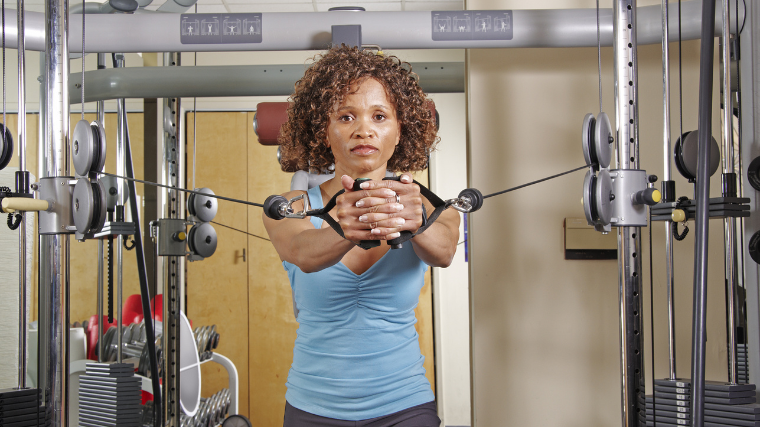
Exercises like the crossover are a fantastic way to burn out every last fiber in your pecs without requiring you to stabilize a heavy barbell to get it done.
Those Crunched for Time
You may not adore cable or machine work, but it can shave minutes off your workout in a pinch. In the event you need to get in, get dirty, and get out of the gym in the blink of an eye, turn to an exercise like the crossover.
Intuitive execution, ease of access, and quick-change loading schemes make it a phenomenal choice if you need to blast your chest as fast as possible.
Powerlifters
Cable training may not be the bread and butter of a powerlifter, but you might want to consider the crossover as an accessory movement.
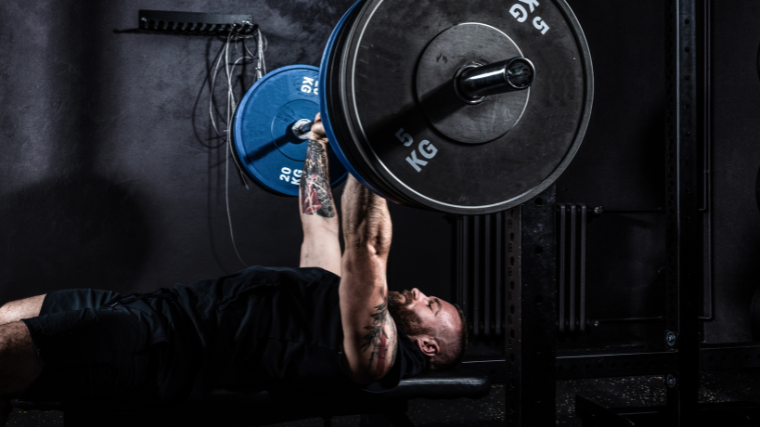
Some lighter non-barbell work can do you wonders if you’re a strength enthusiast, both as a means of staving off boredom and providing a comprehensive resistance profile for your pecs.
Bigger Pecs, Better Hugs
Your chest is a muscle like any other. To build it properly, you need the best tools at your disposal. For most gymgoers in most cases, a healthy combination of free-weight pressing and auxiliary machine or cable work does wonders.
The cable crossover is as good as it gets when it comes to the latter. Consistent resistance, easy to learn and perform, and plenty of adjustability make it suitable for anyone, anytime, anywhere.
If you want to blow up your chest or seek out the perfect strength accessory, cross over to the cable tree and get to work. You’ll pump your pecs and practice for better hugs at the same time.
FAQs
Still have questions about the crossover? No worries, we’ve got answers.
What’s the difference between a crossover and a flye?
These two exercises are identical save for one small distinction. When you perform a crossover, your hands literally pass one another at the end of each rep. During flye movements, your arms come together just until they’re parallel.
Should I stagger my feet during crossovers?
It isn’t a requirement, but you may find that taking a split stance during crossover movements helps you maintain your balance, particularly if you’re doing them with one arm at a time.
Featured Image: Vladimir Sukhachev / Shutterstock